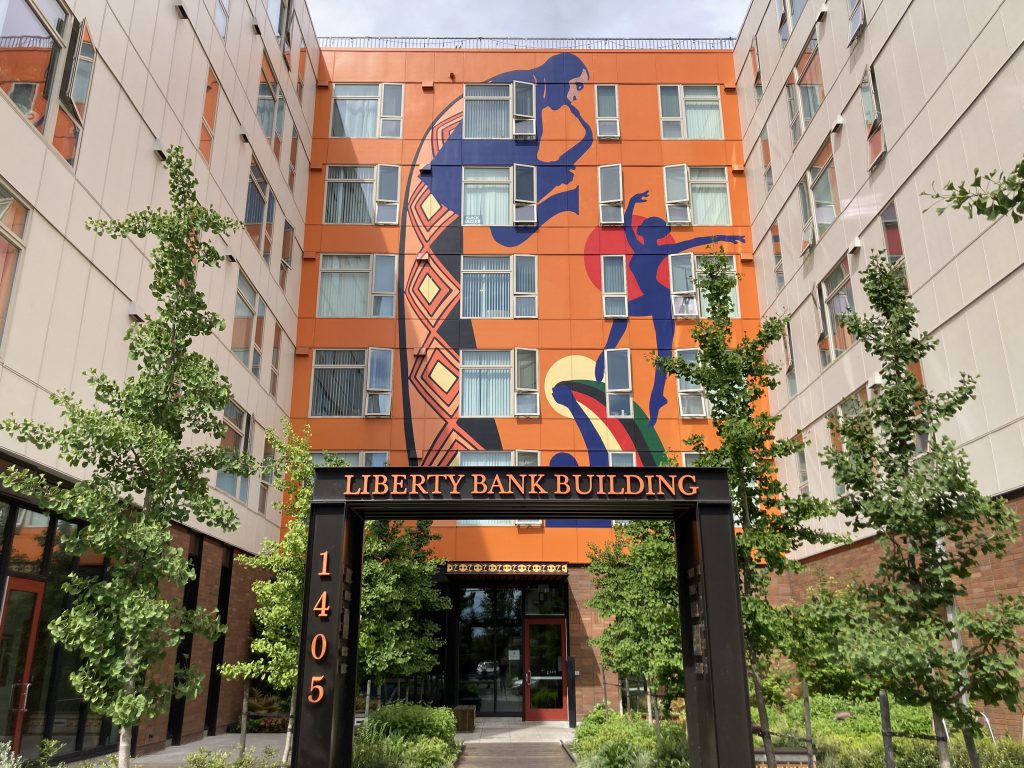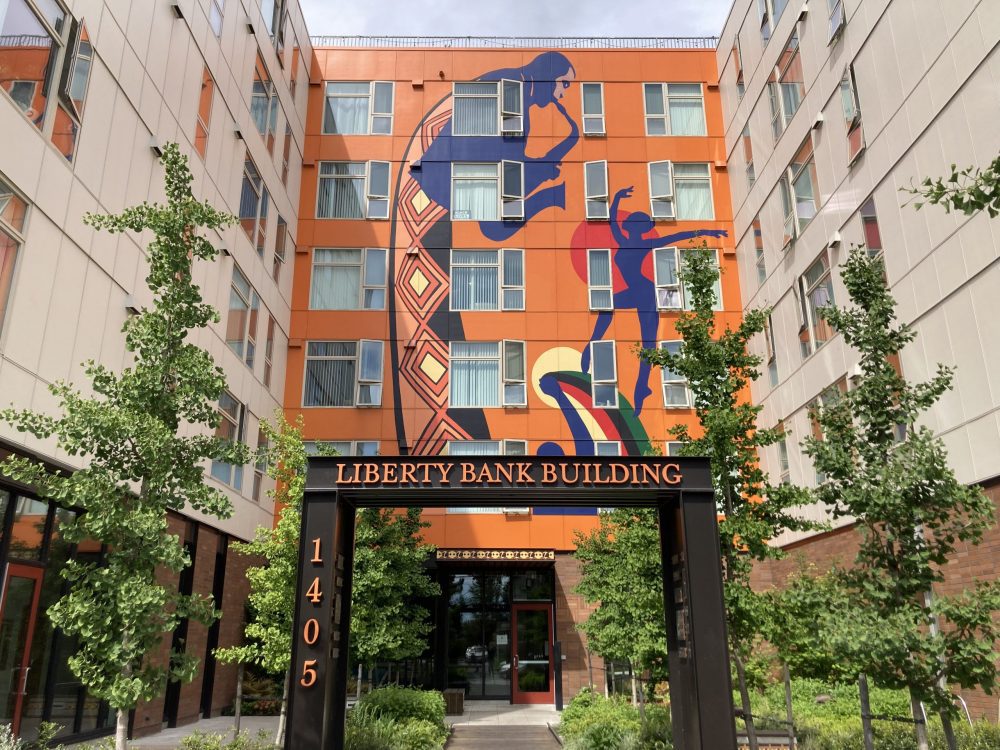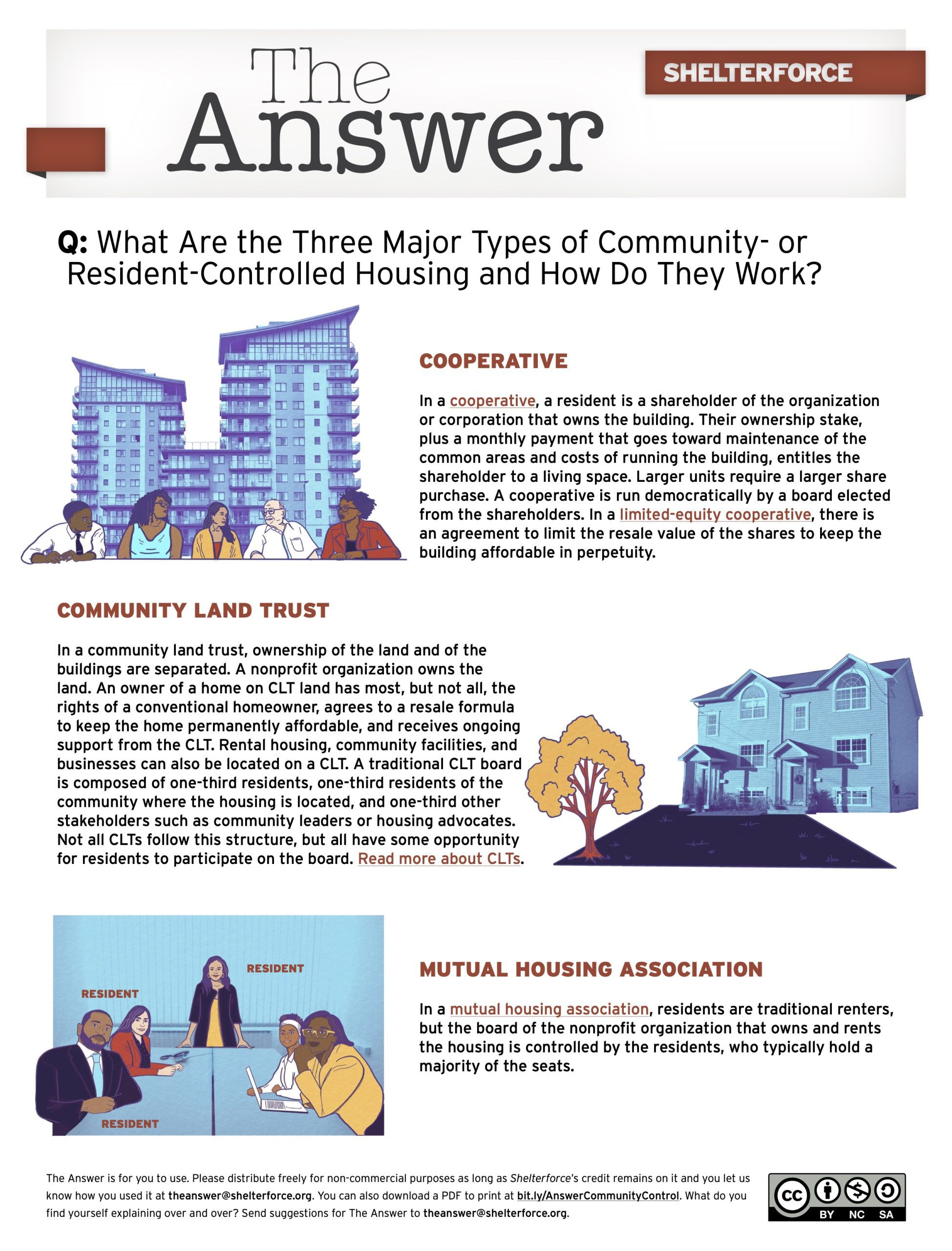
The Liberty Bank Building in Seattle represents a divergence from the typical development projects occurring in the Central District. It has 115 housing units of various sizes for low-income households, and ground-floor commercial space that prioritizes leasing to Black-owned legacy businesses. Photo courtesy of Africatown Community Land Trust
The segment of 22nd Avenue that runs between Union and Cherry is, in many ways, a typical neighborhood in Seattle’s Central District. The narrow, gently sloping street is dotted with large trees that form a dense canopy, providing shelter from the Northwest’s wet winters and increasingly warm summers. Within a couple of blocks, cracked sidewalks lead to boulevards lined with restaurants, stores, and bus routes that connect to the rest of Seattle. Despite being bookended by two of the city’s main thoroughfares, it’s quiet. Not silent, but quiet enough to hear birdsong and chatty neighbors. Medium-sized lots allow residents to live their lives while remaining part of a cohesive neighborhood. It is, in a word, pleasant.
Situated in a region with a historical affinity for exclusionary housing practices, this tree-lined residential street was once one of the only places in Washington state where Black residents could buy property. As a result, 22nd, and the network of streets around it, became the center of a thriving and culturally rich Black community. Boeing workers, teachers, and the like built a middle-class neighborhood where they could raise their families and build generational wealth.
But in the last few decades, market forces have focused their eye on this quiet neighborhood with easy access to the rest of the city. The Central District, once redlined, became a lucrative investment opportunity for developers hoping to cash in on Seattle’s tech and real estate boom. Year by year, houses sold, prices skyrocketed, taxes went up, and Black people left the neighborhood. The impact has been significant. According to municipal records, the Black population in the Central District has dwindled from above 80 percent to below 10 percent.
A City Grapples with its Housing Crisis
This story of the Central District is not new, and certainly not unique on the West Coast. Hands have been wrung for years about gentrification and displacement, even as prices continue to soar. In Seattle, the latest chapter came in the first few months of 2022, bringing renewed vigor to public discourse on housing policy. As Gov. Jay Inslee shepherded an eventually unsuccessful change to statewide zoning laws through the legislature, debate on land development and affordable housing entered the mainstream.
Many of Seattle’s neighborhoods are zoned for single-family housing, meaning construction of duplexes, triplexes, and other multi-unit buildings is prohibited in much of the city. This creates a very real, and widely acknowledged, housing density crisis. As the region continues to boom, the housing deficit makes Seattle’s growth unsustainable. The effort to rezone the city’s neighborhoods to encourage density was an attempt to address this issue, and, despite its failure, the debate is sure to continue.
Even so, though public discourse tends to focus squarely on the merits of doing away with single-family zoning, the real question lies in how we develop density in a way that centers equitable and just access to affordable housing. There is no question that Seattle’s path through its housing crisis will involve significant building, but it is worth keeping in mind that not all development impacts communities in the same way. This fact is evident on 22nd Avenue and in the surrounding neighborhood, where development of single-family residences is all but inevitable. What is in question, however, is the direction that development will take and who the created value will benefit.
On the one hand, large corporations fundamentally motivated by profit stand to extract significant wealth from a building boom. On the other hand, organizations that remain accountable to the community and build in a way that honors the neighborhood’s history hope to stem the tide of displacement. Two recent projects in the area demonstrate this dichotomy and illustrate possible futures for the Central District.
A For-Profit Developer
In the middle of the block on 22nd Avenue, two brand-new homes sit side by side, mirror images of each other except for the paint colors. The houses stand out only in their newness and modern design; neither is significantly larger than the places around them. They are well built, efficient single-family homes sitting on a lot that used to hold one older house in a state of disrepair.
The builder, Thomas James Homes, a California-based, publicly traded redevelopment group backed by investment banking giant Oaktree Capital, acquired the lot on 22nd Avenue at the start of 2020 for $730,000. Soon after acquisition, a demolition permit was granted, black fences with the TJH logo went up, and construction quickly began. After a short time, both houses were built and sold, one for $1,250,000 and the other for $1,195,000. In just over a year, the monetary value of this Central District property had increased by $1,715,000.
Even given the costs associated with building two new houses, Thomas James Homes stood to make a significant profit from this project. The margin, according to the company’s 2021 SEC filing, contributed to an overall gross profit of $45.5 million made by TJH in the first half of 2021. In that same time, it held $502.7 million worth of housing inventory in Southern California, the Bay Area, the Pacific Northwest, and Denver.
The corporation’s stated goal is to enter three or four new “desirable” markets each year. In the SEC filing, it describes “desirable” neighborhoods as urban, with high population density and a significant number of affluent households that are in search of a shrinking number of quality homes. Beyond these first four metropolitan areas, TJH is eyeing 14 more markets nationwide that it sees as integral to its growth. Profit allows expansion, which creates more profit. The money that was made on 22nd Avenue will help TJH build more multi-million-dollar homes in Phoenix and Chicago and Detroit, meaning that money likely will not be reinvested into the Central District or its residents.
Representatives of Thomas James Homes contend that they are building housing where it is needed. Indeed, a central component of their business strategy is to increase density on the lots they purchase. This is consistent with the project on 22nd Avenue, where two residences took the place of one. The difference between this development and the community-owned development that will be discussed in the next section is that the goal of creating density for TJH is to maximize value and potential profit, not to make housing more affordable or strengthen the community that already exists.
The result is a street with two luxury homes, both significantly more expensive than the previous house, driving up property taxes and drawing a whiter, wealthier demographic into the neighborhood.
While for-profit developments like this meet a certain demand for housing in the simplest of terms, they often do little to address the housing crisis that is facing low- and middle-income households. When units are built for the sole purpose of maximizing profit to shareholders, developers have minimal motivation to mitigate the impacts of rising housing costs and displacement. In this environment, density, which normally implies lower prices associated with increased supply, turns into an engine of gentrification and corporate wealth.
A Community Land Trust
A couple of blocks away from the new houses on 22nd Avenue, the Liberty Bank Building sits on a large corner lot. Its orange and white façade, adorned with art created by Black artists, represents a divergence from the typical development projects occurring in the Central District. Built on the former site of the first Black-owned bank in the Pacific Northwest, the driving force of this project was respect for, and the strengthening of, the community that exists in the Central District.
With 115 housing units of various sizes (affordable to households earning between 30 percent, 50 percent, and 60 percent of the area median income) and ground-floor commercial space that prioritizes leasing to Black-owned legacy businesses, the Liberty Bank Building manifests Africatown Community Land Trust (ACLT)’s mission of acquiring, developing, and stewarding brick and mortar communally owned land for the Black diaspora.
[RELATED ARTICLE: Scaling Up—How Some Community Land Trusts Are Getting Bigger]
One of ACLT’s stated goals is the “prioritization of local and minority hiring.” Throughout the development of the Liberty Bank Building, more than 30 percent of the $16.7 million paid to subcontractors went to women- and minority-owned businesses. More specifically, over $2.9 million of that money was awarded specifically to Black-owned businesses, helping keep money in the community.
Started in 2016 as a direct response to displacement in the Central District, ACLT brings together a collection of stakeholders with deep ties to the neighborhood who work to retain and steward its land. In order to remain accountable to this goal, the organization maintains a board and leadership staff that include longtime residents of the community. In fact, the CEO, K. Wyking Garrett, is a third-generation resident of the Central District for whom this work is personal.
Given their commitment to the neighborhood, the leadership and board initiate projects that invest in Seattle’s Black community instead of extract from it. As ACLT puts it, “We are here not for income, but for outcome.”
The most obvious challenge associated with this form of development is acquiring resources. When the primary value created in a project is distributed to the community, and not consolidated in the form of monetary profit, it is more difficult to compete in land and property purchase. As a result, ACLT’s development process can take longer than that of for-profit ventures.
In order to secure the financing for Africatown Plaza, another affordable mixed-use development in the Central District that broke ground in February, the ACLT went through a lengthy funding effort that relied primarily on outside donors. That alone puts the land trust at a disadvantage when trying to counter the blistering pace of displacement wrought by developers with deep pockets and wide enough margins to have multiple projects occurring at once, the way that Thomas James Homes can, for example.
Yet ACLT does not suffer from a lack of ambition. With multiple projects in the pipeline that address affordability, housing stability, and Black homeownership in the Central District, the organization is crafting a model for what equitable development looks like.
When the community and its residents are prioritized over profit, density can become a powerful thing. Targeted and equitable development has the ability to provide our neighborhoods with things they so desperately need: housing, small business space, cultural space, jobs, and community wealth. Longtime residents of the Central District know this, and their efforts are manifested in the continued work of ACLT. By building with purpose, Africatown Community Land Trust provides a vision for what our communities can be: places where density is created to combat displacement, as opposed to intensifying it.
Density—Two Paths Ahead
For longtime residents of 22nd Avenue, and of the Central District as a whole, the neighborhood is changing. As Seattle continues to boom, properties on their street will be bought and sold, new structures will be built, and new generations of Seattleites will walk beneath the shelter of their large trees. Increased development, in the form of houses, apartments, and everything in between, is both inevitable and necessary to sustain the region’s growth. But that does not have to mean the value of the neighborhood must be based entirely upon square footage and market rates. Density can be built in a way that honors history, culture, equity, and community. Whether that happens hinges upon who is developing the land. Income or outcome. It’s time to decide.





Comments